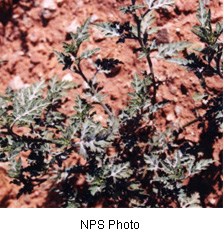
Ambrosia acanthicarpa Synonyms: Franseria acanthicarpa; Gaertneria acanthicarpa Family: Asteraceae (A Utah Flora – Compositae) – Sunflower Family Annual herbs; 3.5” to 2.5' (0.9 to 7.5 dm) tall Leaves: opposite below, alternate above; simple; lobed bipinnatifid to pinnatifid; blades 0.36” to 3.8” (0.9 to 9.5 cm) long, 0.24” to 3” (0.6 to 7.5 cm) wide Flowers: disk flowers; flower head appears to be a single flower, but is composed of several flowers (a composite). The corolla is lacking. There are many tiny greenish flowers on the stem facing downward. Flower heads are unisexual. Male flowers are separate and above the female flowers. Pollinators: other Ambrosia species are pollinated by insects Fruits: achene – 1 seeded with hard shell covered with curved spines Blooms in Arches National Park: August, September, October Habitat in Arches National Park: desert shrub, pinyon-juniper and riparian communities; often in sand Location seen: widespread, Windows trailhead Other: The genus name, “Ambrosia”, comes from “Ambrosia” in Greek mythology which was the food of the gods and refers to the sweet smelling odor of this plant. The genus name, “Franseria”, honors Antonio Franseri, an 18th-century Spanish botanist. The species name, “acanthicarpa”, means “with thorny fruits like those of Acanthus”. Ambrosia and Franseria species have been known to cause hay fever, asthma, and dermatitis. This family is the most advanced and complex of the dicots. The family is rich in oils and resins and is found in every part of the world, but is infrequent in the tropical rainforest. Aquatic or semi-aquatic species are also uncommon. |
Last updated: April 29, 2025
